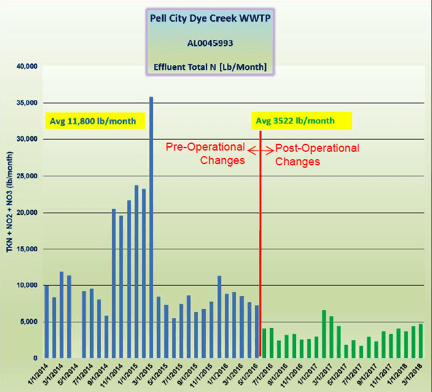City of Pell City recognized by ADEM & ADECA for Wastewater Plant Efficiency
Published 11:35 am Thursday, June 7, 2018

- The attached chart, compiled by ADEM, outlines the nitrogen discharge loadings from the WWTP with pre-operational changes shown in blue and post-operational changes in green. Nutrients in the effluent from the WWTP have been reduced by more than 8,000 pounds per month, or 50 tons per year
The City of Pell City was recently recognized as a top participant in the Alabama Wastewater Energy Management Initiative, recognizing the highest level nutrient reduction to date.
In 2015, The City of Pell City participated in a voluntary energy conservation study at its Dye Creek Waste Wastewater Treatment Plant (WWTP). The study involved an intense evaluation of the facility, led by a team of professionals from the U.S. Department of Energy, U.S. Environmental Protection Agency (EPA), Alabama Department of Environmental Management (ADEM), Alabama Department of Economic and Community Affairs (ADECA), and the University of Memphis. Based on the findings of the study, various operational changes were implemented in June 2016, with one of the results being a significant increase in denitrification resulting in reduced nutrient (nitrogen) loading to the Coosa River/Logan Martin Lake.
While Nitrogen is an abundant natural part of the ecosystem, levels above those naturally occurring can have a wide range of detrimental effects, to include increases in algae, which in turn can harm water quality, food resources and habitats, and cause decreased oxygen levels.
The attached chart, compiled by ADEM, outlines the nitrogen discharge loadings from the WWTP with pre-operational changes shown in blue and post-operational changes in green. Nutrients in the effluent from the WWTP have been reduced by more than 8,000 pounds per month, or 50 tons per year.
Joe Dan Harmon, Chief Operator of the WWTP, said that the introduction of a new control protocol was instrumental in the reduction, with the aeration system being turned off at night to allow more thorough processing by the creation of an “anoxic zone.” The lowered run time also helped to save energy.
In addition to the reduction in nutrient discharge to the Coosa River/Logan Martin Lake, the operational changes have reduced power consumption by an average amount of $1,300 per month, saving an annual amount of $15,600 on energy costs at the WWTP. With the positive results from the operational changes, the WWTP operators are continuing to fine-tune operational changes and explore other potential modifications that may further improve effluent quality and power savings.
The City recently received an award for its efforts at an ADEM event in Prattville, with City Manager Brian Muenger accepting the award from ADEM Director Lance LeFleur and ADECA Director Kenneth Boswell.
“The Energy Management Initiative was an excellent experience for the City,” Muenger stated. “The City recognizes the importance of minimizing its impact on our natural resources, the improvements that have been made will have a recurring positive impact on the environment.”
Muenger recognized Joe Dan Harmon, Chief Operator of the WWTP, as the leader of the effort, “Mr. Harmon and his fellow Operators take immense pride in their jobs, we are fortunate to have such a dedicated and experienced staff.”



